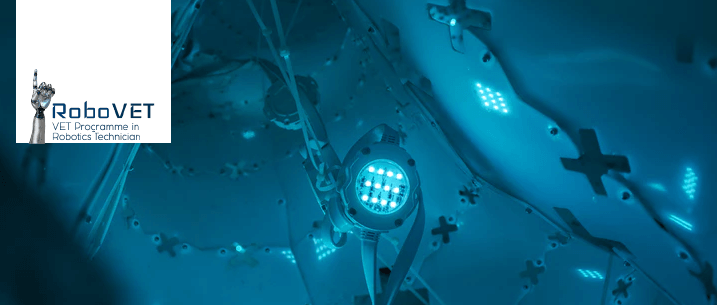Project Description

ROBOVET
Definition and Implementation of a VET programme in Robotics Technician
The European Agency for safety and health at work in its discussion paper “A review on the future of work: Robotics” states that according to the EU Robotics Strategy 2020 “Robotics Technology will become dominant in the coming decade. It will influence every aspect of work and at home. Robotics has the potential to transform lives and work practices, raise efficiency and safety levels, provide enhanced levels of service and create jobs.”The creation of the joint VET qualification in Robotics will match the market needs of complex and transferable skills by supplying young people with interdisciplinary profiles and the right skills to enable competitiveness and innovation. This will contribute to the increase of the employability of young people highly skilled and qualified. By creating a new qualification for VET, the partners will contribute to improving the capacity of VET systems to respond to skills needs and for the attractiveness of VET as the first choice.
Flyer with further information in English or Spanish language.
The «talent crisis» requires
Therefore, the overall goal of the MEDIS project is to strengthen and consolidate social cohesion, intercultural education and local language in a multilingual framework of newly arrived migrants at primary and secondary schools through the Mediterranean Inclusive Schools Programme.
The project will meet the 3 objectives foreseen, as follows:
To increase the employability of young people–Most partner countries have high youth unemployment levels, according to Eurostat (Dec. 2017): Portugal -25.6%, Spain -38.2%; Greece -40.2% and Cyprus -24.9%. The International Robotics Federation estimates an average annual 12% growth of robots in industry, meaning that there is no labor force to cope with this growth rate. The future of the industry is Robotics (https://www.theguardian.com/us-news/2017/jun/26/jobs-future-automation-robots-skills-creative-healthand https://www.mckinsey.com/global-themes/employment-and-growth/automation-jobs-and-the-future-of-work), therefore youth should have proper training in this area of expertise. Consequently, the design of a new joint qualification in VET in Robotics will translate into a reduction of the Eurostat figures by matching the market needs to the qualifications. By creating a new qualification to bridge the gap between education and training and the labor market, the project will contribute to increasing youth employability.
To contribute to the development of a highly skilled, qualified and mobile workforce from which companies should also benefit –Robotics implies a degree of specific, highly skilled knowledge. It congregates different knowledge fields, meaning that the VET students will also be prepared to apply for jobs in electronics, electricity, and mechatronics, enlarging the job prospects. The new perceived areas to be included in the Course are related to 3D printing and Soft Skills, which will endow the students with strategic skills for sustaining jobs and contribute to competitiveness and innovation. The Course will be designed to develop transferable skills, such as the ability to work in a team, creative thinking and problem-solving.The companies will benefit from this workforce, whose learning process will be focused on work-based learning, as the students will have flows of traineeships. These will facilitate the transition to work by allowing the trainees to develop labor market relevant skills.The quality assurance systems based on the European Qualifications Framework will contribute to the mobility of the workforce as the mutual recognition of the qualifications will act as a device for securing the free movement of professionals in the new concept of global working place.
To support joint developments in VET in Europe and strengthen overall its quality, relevance, and Attractiveness.The project will address this objective by designing a joint qualification in VET. This new qualification intends to match the market needs and also to introduce the innovation factor in VET offers that will contribute to its attractiveness. In addition, it will be conceived to allow transferability and mutual recognition of qualifications, which makes it more appealing for the future workforce and for the same purpose, it will allow the innovative use of technology in VET.
CHECK OUT OUR NEWSLETTER.
December 2018
July 2018
January 2020
November 2020
Project Details
- ClientP. Number: 597847-EPP-1-2018-1-PT-EPPKA3-VET-JQ European Comission Erasmus +
